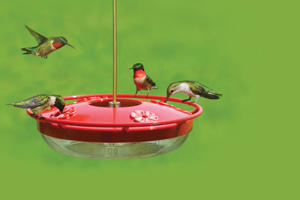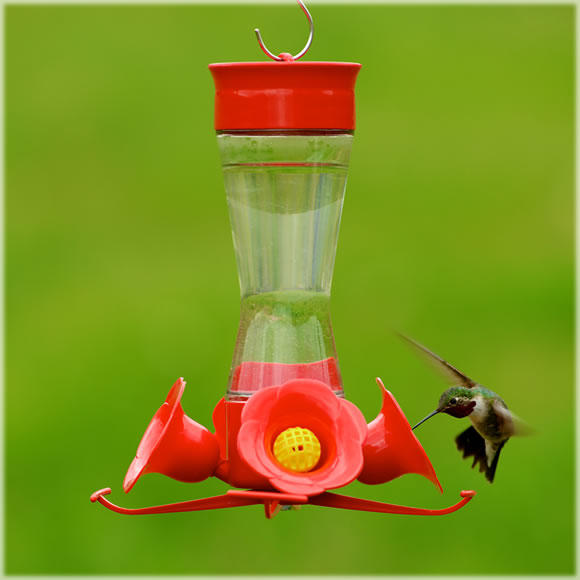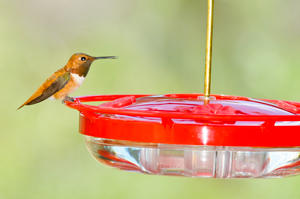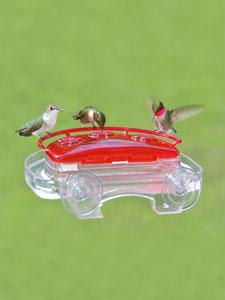How to Attract Hummingbirds

The WBU recommendation for hummingbird nectar is a 4:1 ratio; 4 parts water to 1 part sugar. The overwhelming recommendation in the industry for making hummingbird nectar is a solution of 4 parts water to 1 part white table sugar (sucrose). This concentration has proven safe and attractive to hummingbirds. It also mimics the natural concentration (20%) of the average natural nectar sources on which hummingbirds feed.There is some concern that increasing the ratio beyond 3:1 may cause dehydration and kidney damage in hummingbirds due to the lower concentration of water in the solution. While we have been unable to find a definitive research document to confirm this, we believe being cautious is the best approach for now.Another advantage to the 4:1 concentration is that hummingbirds will feed more frequently on a weaker solution than on a stronger one. Thus they may visit your feeder 10 to 12 times an hour in comparison to three or four times an hour with a richer solution.
Fun Facts about Hummingbirds

Hummingbirds in the Vancouver Area
Our most common species, Anna’s Hummingbird, is present all year round. Males are easily recognized by their iridescent red heads; females are gray and green with an iridescent throat patch. We also see Rufous Hummingbirds, to the right, during the spring and summer.
Feeder Basics
Hummingbirds can be attracted to feeders offering sugar water, in imitation of the natural nectars found in flowers. This is a safe and beneficial food for hummingbirds, who will also continue to consume insects and visit natural flowers. Use a formula of 4 parts water to 1 part plain table sugar. Avoid sugars marketed as "natural" if they contain anything other than pure sucrose or have any golden or brownish tint; these less purified sugars contain higher amounts of iron, which may harm hummingbirds.There are also a variety of commercial mixes sold as hummingbird food. The mixes we sell are made of pure sucrose, chemically identical to standard table sugar, but are ground into finer crystals to make dissolving easier and heating of water unnecessary. We also carry a liquid concentrate, which mixes with additional water extremely easily. We do not carry or recommend nectar solutions containing red dye, which is unnecessary and possibly harmful to hummingbirds. To the best of our knowledge, the various mixes which claim to be enriched with vitamins or electrolytes have no scientifically demonstrated benefit to hummingbirds and we are inclined to avoid them.Click here for a copy of our recommended sugar water recipe!
Feeder selection
Saucer-style feeders with a simple basin and lid generally are the most functional and have fewest problems. Traditional feeders with upside down bottles are difficult to clean and often develop leaks. Feeders that attach to windows using suction cups allow you to watch birds from very close distances. An 8-12 oz. capacity is sufficient for most people; only use a larger feeder if your birds empty it within a few days. All Wild Birds Unlimited feeders are made in the USA, have a built-in ant moat, and come with a lifetime guarantee.



Saucer-style feeders (left) are easier to clean and never leak, but traditional or decorative models will also attract hummingbirds.
Watch this video on how to choose the best hummingbird feeder!
Recommended Feeders
How often does a hummingbird flit in to the nectar feeder, take a drink and dart off too quickly for you to get any decent looks? What about flying to the backside of a feeder where you can’t see them? What if you could slow them down to get a longer look and see them anywhere on the feeder?
The WBU High-Perch Hummingbird Feeders are the answer. We recommend using the Wild Birds Unlimited High-Perch Hummingbird Feeder to attract the most hummingbirds to your yard.
Designed to appeal to hummingbirds, this feeder allows them to hover or perch while feeding. It does not leak. Bees can’t access the nectar solution, and the built-in ant moat deters ants. The feeder is easy to clean, and the nectar solution recipe is on the feeder.
Based on our standard feeder, the Wild Birds Unlimited Decorative Window Hummingbird Feeder brings the birds in for closer views. Watch their tongues lap up the food, darting in and out of the nectar solution up to 12 times per second. It is the only window hummingbird feeder that contains an ant moat.



Feeder Feeder Care
Nectar should be changed about once a week to prevent spoiling, or more often in hot weather (as often as every 1-2 days). To avoid wasting nectar, only fill your feeder to a level the hummingbirds can empty in a few days; keep a pitcher of nectar in your refrigerator for up to two weeks and refill your feeders as needed. When you refill your feeder, rinse it out first with warm water. Every month or so perform a more in-depth cleaning, soaking the feeder in a 10% bleach or vinegar solution. Some feeders can also be cleaned in dishwashers.
Bees and Ants

Many people feed hummingbirds for years and never have a problem with insects finding the sugar water. But some people do. The first thing to do is make sure you are using a feeder that does not leak; saucer-style feeders are generally more reliable in this regard than upside-down bottle feeders, which often have plastic threads or rubber stoppers that wear down over time. Bottle feeders also generally have nectar reachable very close to the feeding port, while saucer style feeders keep the nectar level somewhat below the top of the port, allowing long-beaked and long-tongued hummingbirds to access the sugar water while excluding smaller insects. Some feeders may be fitted with bee guards to completely exclude insects from the nectar solution.Ants and crawling insects can be excluded with an ant moat containing plain water. Many saucer-style feeders have this feature built into the feeder, but you can also purchase separate ant moats that can be hung above any feeder.
Lack of Hummingbirds
Throughout the year, feeder traffic will fluctuate with the abundance of natural food and nesting behavior: abundant flowers may mean that birds spend less time at your feeders, while the needs of nesting may keep birds close to their nesting site and mean they spend their time catching insects to feed their nestlings. While wild birds may not be as constant a presence as captive animals, learn to appreciate their freedom and their integration with a larger world beyond your feeders: they're probably just off somewhere being hummingbirds, and they will return.
When putting out a new feeder, birds often take some time to recognize it as a food source. While bright red feeders may grab hummingbirds' attention more quickly, all of the feeders we carry will attract hummingbirds given patience. Sometimes, that patience is necessary. A few days of waiting is typical if hummingbirds are already in the yard, but a few weeks is not uncommon, and sometimes it takes several months. Remember to keep nectar fresh, replacing the sugar water at least once a week (don't fill the feeder all the way up if they are not drinking it yet). If hummingbirds seem to reject a new feeder in favor of an old one, don't blame the feeder; hummingbirds are creatures of habit and they will not necessarily be in a hurry to investigate a new and unfamiliar object - especially if they have continued access to a known food source. It may help to temporarily stop filling the old feeder, placing the new (filled) feeder somewhere nearby. If the new feeder is not conspicuously red, as some more decorative models are, it may also help to temporarily attach a red ribbon to the feeder to draw the hummingbirds' initial attention.
Local Plants to attract Hummingbirds


